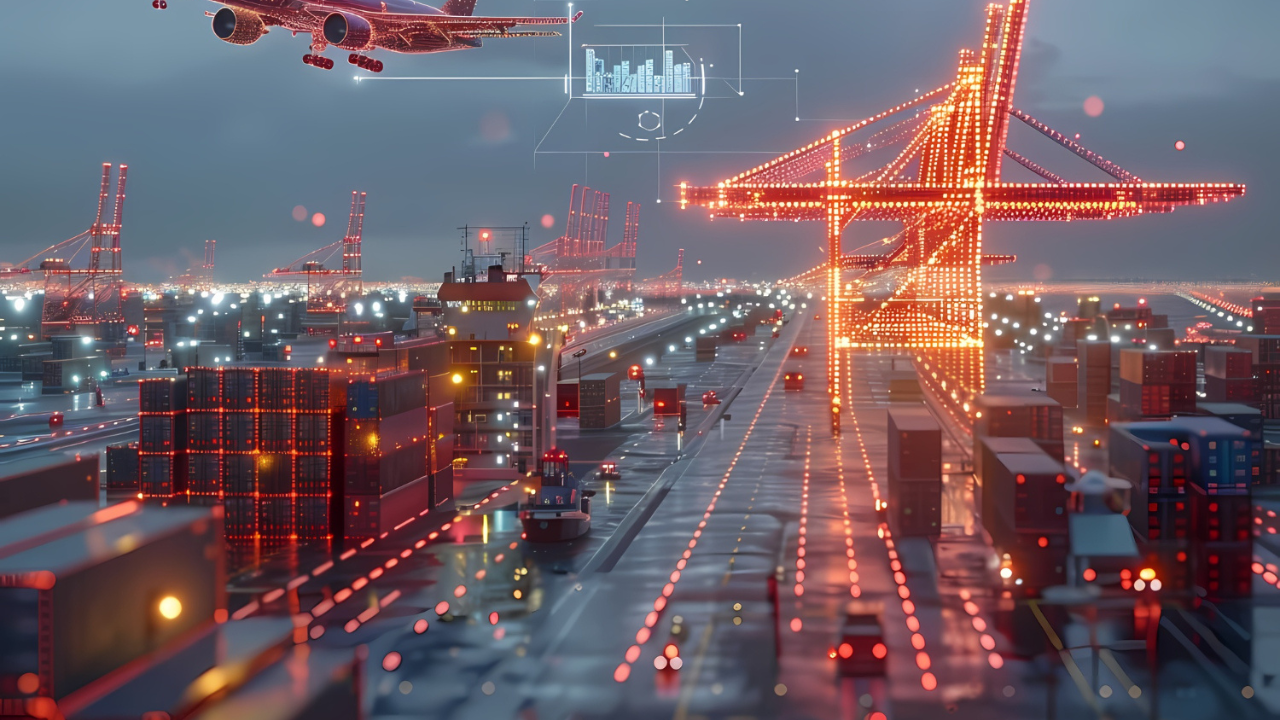Emerging Trends Shaping The Future Of Global Supply Chains
29 October 2025
7 Mins Read

- What Are The Emerging Trends That Will Decide The Future Of the Global Supply Chain?
- 1. Artificial Intelligence And Machine Learning Integration
- 2. Blockchain For Enhanced Transparency
- 3. Internet Of Things (Iot) For Real-Time Monitoring
- 4. Sustainability Initiatives
- 5. On-Demand And Urban Warehousing
- ● On-Demand Warehousing
- ● Urban Warehousing
- 6. Autonomous Vehicles And Drones
- 7. 5g Connectivity
- 8. Third-Party Logistics (3PL) Partnerships
- 9. Risk Management And Resilience
- The Future Of Global Supply Chains Explained
I’ve been following supply chain stuff for a while, and wow, it’s wild how much has changed in just a few years.
It used to be all about cutting costs and getting things there on time — simple, predictable. But now?
It’s more like a living system that’s constantly adapting.
Technology’s rewriting the rules, customers expect transparency, and global events keep throwing everyone off balance.
Businesses have had to rethink everything — not just how to move goods but how to stay flexible and transparent while doing it. The new goal isn’t just “get it there fast.” It’s more like: “get it there safely, ethically, and still make a profit.”
And honestly, tech is doing a lot of the heavy lifting. AI, blockchain, real-time data — all that jazz — gives companies eyes everywhere.
Warehouses are getting more automated, which means fewer mistakes and quicker deliveries.
I saw a freight company using data-driven tools to adjust routes instantly when demand spikes. It’s nuts. But it works — better accuracy, faster reactions, and fewer headaches.
At the same time, sustainability’s become a deal-breaker. Consumers and governments are done giving passes to brands that ignore the environment.
As a result, many companies are reducing their emissions, adopting greener packaging, and relocating production closer to home.
It’s not just about saving the planet (though that’s nice); it’s also smart business. Less risk, shorter supply lines, and a brand image people actually trust.
All of this feels like a slow but massive shift. I will close up on the future of global supply chains that are smarter, cleaner, and way more connected than before.
What Are The Emerging Trends That Will Decide The Future Of the Global Supply Chain?
These are the prime factors:
1. Artificial Intelligence And Machine Learning Integration
AI and machine learning aren’t just buzzwords anymore — they’re basically running the show.
Companies are using them to predict what’s about to happen before it even happens — demand swings, inventory issues, shipping delays, you name it.
The crazy part? The algorithms can spot trends no human would ever see buried in the data. So instead of reacting after the stock runs out, teams can shift gears early and keep customers happy. Plus, it saves money — fewer stockouts, less stuff collecting dust on shelves.
Real-time AI dashboards are also helping managers catch problems early.
If something looks off, they can adjust routes or schedules before things go sideways.
It’s not magic, but it’s close. And apparently, it can cut logistics costs by something like 40%, which… yeah, that’s huge
Forefront freight forwarding demonstrates how digital tools and data-driven logistics models enable organizations to respond more quickly to demand fluctuations and streamline their international operations.
2. Blockchain For Enhanced Transparency
Now, blockchain — that’s a tricky one. Most people still think “crypto,” but in logistics, it’s way more practical than that. Basically, it’s a shared digital record that no one can mess with. Every step a product takes — from factory to store shelf — gets logged in there.
It’s a lifesaver for industries like pharma or food where you have to prove things are real and safe. If someone wants to trace where a batch came from, it’s all there. No guesswork. No shady middlemen.
It also makes audits less painful because everyone’s working off the same verified info. No chasing down spreadsheets or arguing over who’s right. It’s not flashy, but in a world where trust is fragile, blockchain keeps people honest.
3. Internet Of Things (Iot) For Real-Time Monitoring
IoT is one of those quiet revolutions that nobody really notices until you see it in action. We’re talking GPS trackers, smart sensors, connected forklifts — all feeding data back in real time.
For sensitive products like medicine or food, this is a lifesaver. If a truck’s temperature spikes or a shipment gets delayed, someone gets an alert right then and can fix it before it becomes a problem.
But the real beauty is in the data. Over time, these devices show you where delays happen, which routes waste fuel, and even which machines are underused. It’s like having X-ray vision for your supply chain — you just see everything.
4. Sustainability Initiatives
Let’s be honest — supply chains haven’t exactly been eco-friendly. Trucks, ships, packaging, all of it adds up. But lately, companies are getting serious about cleaning up. We’re seeing electric delivery fleets, smarter route planning, and way less wasteful packaging.
People notice that stuff now. Customers don’t just want good products — they want to feel good about buying them. So brands that actually put in the work are earning loyalty, while others get called out.
And it’s not just customers pushing it; governments are setting stricter rules, too. The clever companies are getting ahead by baking sustainability right into how they choose suppliers or design warehouses. It’s good for business, and it feels like the right thing to do.
5. On-Demand And Urban Warehousing
There are two important categories here that you must consider:
● On-Demand Warehousing
This one’s brilliant. Instead of committing to a big warehouse year-round, companies can now rent space when they need it. It’s flexible, kind of like Airbnb for inventory. E-commerce brands especially love it since sales can spike out of nowhere.
Digital platforms handle the matching — retailers find available space fast, and it keeps costs tied to what they’re actually selling. It’s lean, it’s smart, and it keeps supply chains moving without the dead weight of fixed expenses.
● Urban Warehousing
And then there’s urban warehousing — small storage hubs right in or near cities. Makes sense, right? Most people live in cities now, and everyone expects same-day delivery. These little local hubs make that possible without the crazy costs of long-distance trucking.
They’re popping up in old retail spaces, underused buildings, even underground in some places. It’s fast, eco-friendlier, and perfect for the “I need it now” world we live in.
6. Autonomous Vehicles And Drones
I still remember when self-driving trucks sounded like science fiction, but they’re slowly becoming a thing. Long-distance freight is testing it out because it saves time, fuel, and, well, drivers can only do so many hours.
Drones are the other side of that coin — tiny, efficient, and great for local or rural deliveries. They’re not perfect yet (regulations and weather can mess things up), but it’s coming. Companies are already running trials, and once the laws catch up, it’s going to explode.
Together, they could totally reshape last-mile delivery — faster, cheaper, and maybe even safer in the long run.
7. 5g Connectivity
Now, this one doesn’t sound exciting, but 5G changes everything. Imagine every truck, sensor, robot, and worker connected instantly — no lag, no delays. That’s what 5G brings to the table.
Warehouses can sync hundreds of devices at once, fleets can reroute live, and even AR tools for workers can run without glitching. It’s what ties all the fancy tech — AI, IoT, automation — together into one seamless system.
With that kind of real-time feedback, companies can spot disruptions early and react almost instantly. Basically, 5G is the glue that makes modern supply chains actually work.
8. Third-Party Logistics (3PL) Partnerships
Let’s be honest — running logistics on your own these days is a nightmare. So a lot of businesses are teaming up with 3PL providers who already have the networks, the tech, and the know-how.
As supply chains become increasingly complex, businesses are increasingly outsourcing logistics activities to specialized third-party logistics (3PL) partners.
It’s not just outsourcing; it’s more like having a strategic partner who’s seen every shipping disaster imaginable and knows how to dodge it. 3PLs can scale up or down fast, which helps when markets get unpredictable.
They deal with customs, paperwork, and compliance too — all the stuff no one wants to touch. In short, 3PLs give companies the breathing room to focus on what they actually do best.
9. Risk Management And Resilience
If recent years taught us anything, it’s this: assume something will go wrong. Pandemics, wars, freak weather — you name it. The smart move now is to plan for chaos.
That means having backup suppliers, keeping some extra stock, and using analytics to spot weak points early. More companies are also using digital tools to map their whole supply chain, so when something breaks, they already know Plan B (and C).
It’s less about avoiding every problem and more about bouncing back fast when one hits. Resilience is the real competitive edge now.
The Future Of Global Supply Chains Explained
So yeah, the future of global supply chains isn’t just about trucks, ships, or data dashboards. It’s about adapting — fast. The winners will be the ones who lean into tech, stay transparent, and care about the planet while they’re at it.
AI, automation, and smart partnerships are already separating the flexible from the fragile. And honestly, that’s what it comes down to — being able to pivot when the world throws its next curveball.
The companies that figure that out? They’re the ones that’ll still be standing in ten years.
Read Also:



















Comments Are Closed For This Article